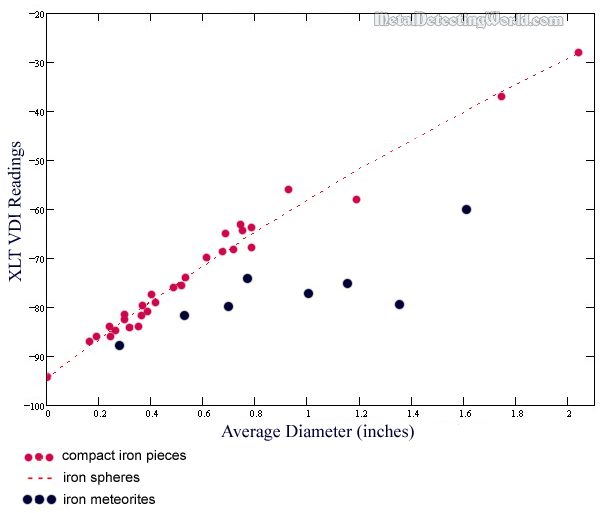METEORITE HUNTING, page 4
How To Distinguish a Meteorite from Terrestrial Objects by a Metal Detector: Tutorial
The ability of iron-nickel content in reducing the conductivity of meteorites can be successfully used to distinguish a meteorite from any piece of iron or "hot rock." However, "hot rocks" turn out to be meteorites of Stony Iron type in 25% of cases. A metal detector has a slightly delayed reaction to "hot rocks" after a search coil passes them. Iron meteorites are known to give an immediate response to the metal detector.
The most useful metal detector for distinguishing meteorites from iron pieces is White's Spectrum XLT or XLT E-Series because of its features such as S.A.T. control and V.D.I. (Visual Discrimination Identifier) with V.D.I. numbers displayed. The Conductivity scale shown on Spectrum XLT's display runs from -95 to 0 ("iron" section) and from 0 to +95 ("non-iron" section).
So if you found an object of iron content, but you are not sure whether it is a meteorite or not, you could do the following:
NOTE: White's Spectrum XLT or XLT E-Series is required for this method.
1) Weigh the object and get the weight number in grams. Then you need to calculate its diameter, as if it was a sphere, by the formula shown below.

2) Get the object's V.D.I. number. If it is not a perfect sphere - most likely, it would have as many different V.D.I. numbers as many sides it has. So you obtain the V.D.I. numbers by scanning an object twice along each side and then you calculate an average of all V.D.I. numbers you got.
NOTE: If the shortest side gives out readings that are much smaller (or bigger) than the readings of other sides, exclude these two umbers from calculation. This method is not working for the objects that are very flat and long, or having holes in them.
3) By putting your two calculated numbers into the chart below, you can determine whether the object is a meteorite (positioned far away from the red dotted line) or just a piece of iron (positioned close to the red dotted line).

NOTE: The smaller the size of an iron piece, the more negative the V.D.I. reading would be (moving further to the left on the XLT's Conductivity scale and stopping at the cut-off point of -95). With a diameter approaching zero, V.D.I. numbers of iron pieces and iron-nickel alloyed meteorites would get very close to each other, thus, making it extremely difficult to see the difference between them. The XLT is not useful if the object's weight is less than 1g.